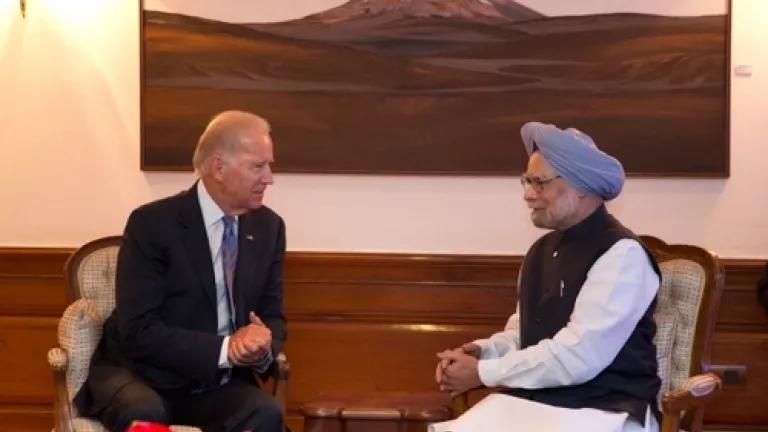Vice President Biden Continues to Build Momentum on U.S.-India Climate Cooperation to Spur Action on "Super Greenhouse Gases"

In India, United States Vice President Joe Biden advanced momentum on U.S.-India discussions to combat climate change earlier this week. His trip marked the first visit from a United States vice president to the nation in almost three decades. He stressed the importance of a stronger U.S.-India strategic partnership, including working toward a global phase-down of “super greenhouse gases,” known as hydrofluorocarbons (HFCs). Reducing HFCs is a critical opportunity for the United States and India to make a global impact on climate change in the near term. Vice President Biden’s message echoes Secretary of State John Kerry’s discussions in June and tees-up HFCs as a priority for Prime Minister Dr. Manmohan Singh’s summit with President Barack Obama in Washington this September.
Vice President Biden meets with Prime Minister Dr. Manmohan Singh Photo in New Delhi on July 23, 2013; Photo: White House Photo by David Lienemann
HFCs have been a hot topic in the past few months. In addition to Vice President Biden, India has received several senior U.S. officials this year, starting more recently with Secretary Kerry, Secretary of Energy Ernest Moniz, former Secretary of Energy Steven Chu, Special Envoy Todd Stern, Deputy Secretary of State William Burns, Under Secretary of State Robert Hormats, and others, with the aim to elevate discussions with the Indian government on clean energy, climate change and phasing-down HFCs. And in September, Prime Minister Singh will be traveling to Washington to meet with President Obama.
HFCs are coolants used in refrigeration and air conditioning systems worldwide. They were introduced to the market mainly as a replacement to CFCs (chlorofluorocarbons) and HCFCs (hydrochlorofluorocarbons), which were phased out under the Montreal Protocol. While HFCs do not destroy the ozone layer, they are “super greenhouse gases” because they warm the climate at least 1,000 times more than an equal weight of carbon dioxide in the atmosphere. HFCs are the fastest growing greenhouse gas in the U.S., Europe, China and India, and are expected to reach nearly 20 percent of total greenhouse gases in the atmosphere by 2050. The primary use of HFCs in India is in automobile and room air conditioners.
NRDC with our partners, the Council on Energy, Environment and Water, The Energy and Resources Institute and the Institute for Governance & Sustainable Development recently released a report highlighting the business case for India to move away from HFCs. The report, Cooling India with Less Warming, discusses lower-impact alternatives that India could use to “leapfrog” HFCs in its phase-out of outdated refrigerant technology. The report analyzes the Indian market and how Indian room air conditioning and car companies are ready to use new technologies but need policy direction to broaden the market.
June marked a shift in global progress on phasing down HFCs. The United States and China announced an agreement to work together to phase-down HFC production and use. During his visit to India, Secretary Kerry discussed stepping-up action on climate change, including phasing down HFCs in the near term (see NRDC President Frances Beinecke’s letter to Secretary Kerry). In Bangkok, the Montreal Protocol Working Group cut down major barriers by opening the dialogue on legal issues, technical feasibility, and financial impacts of a global HFC phase-down. Following this momentum, President Obama included HFCs as a central part of his U.S. National Climate Plan.
Many developed countries are already taking action to reduce HFC use. For example, the European Union Mobile Air Conditioning Directive requires air conditioner refrigerants in all new cars in 2017 to use refrigerants with global warming potentials of about a tenth of the traditional refrigerant. Companies in India were among the first in developing countries to make air conditioners with low global warming potentials for the European market. In the United States, President Obama directed the U.S. EPA to approve low global warming potential refrigerants and prohibit climate-harmful alternatives.
During his visit, Vice President Biden remarked on India’s commitment to sustainable economic growth and said, “[u]nless we can develop a sustainable path on a low-carbon path, the consequences of climate change will seriously undermine the development and growth, as well as harm the very health of the people of India.” With skyrocketing room air-conditioning and air-conditioned car sales, transitioning away from HFCs is a critical step in achieving low-carbon growth and combating climate change.
The United States is eagerly awaiting Prime Minister Singh’s visit at the end of September. This is a huge opportunity for President Obama to work with Prime Minister Singh to agree to phase-down HFC use, similar to the recent agreement between the United States and China. Cooperation on climate change between the United States and India, the largest democracies in the world, could serve as a catalyst for global action on climate change, with HFCs as the key near-term opportunity.
Co-authored by Sarah Klug, NRDC MAP Fellow
